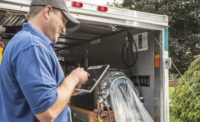MORE THAN A TRADE
According to the U.S. Bureau of Labor Statistics’ (BLS’)Occupational Outlook Handbook, the demand for HVACR mechanics and installers is expected to experience faster-than-average growth, increasing 19 percent over 10 years. This translates to a 51,300-person increase between 2004 and 2014.“As the population and the number of buildings grow, so does the demand for climate control systems,” determined the study, released in 2006. “Excellent job opportunities are expected, particularly for workers who train in an accredited technical school or in a formal apprenticeship program.”
Among the multiple accredited training offerings available in many different states, the United Association of Journeymen and Apprentices of the Plumbing and Pipe Fitting Industry (UA) has intricately partnered with Washtenaw Community College (WCC), Ann Arbor, Mich., to provide more than just accredited training to its program participants.

The United Association of Journeymen and Apprentices of the Plumbing and Pipe Fitting Industry (UA) has intricately partnered with Washtenaw Community College (WCC), Ann Arbor, Mich., allowing students access to tools, equipment, and technology.
The building is also equipped with live and fully interactive video equipment, allowing a teacher to instruct almost any classroom, not only in the Great Lakes Regional Training Center, but also in any of the UA’s other training facilities throughout the United States and Canada equipped with ISDN lines and teleconferencing equipment. The UA training department also offers a variety of HVACR-related Web-based classes, and spends over $110 million on training annually.
In the past, trades have been classed as the professions for those who couldn’t “find” a profession. UA University dispels this myth, offering complete degree courses. With UA’s Five Star Training program, students are able to turn their interest in HVACR into a career.
Upon completion of UA Star certification, technicians will have completed a five-year training program and passed the UA Service Technician Air Conditioning and Refrigeration (STAR) certification exam. This gives each technician service journeyman status and 32 hours of college credit toward an associate’s degree in HVACR or Construction Supervision, which can be earned while simultaneously training. UA University has also partnered with Ferris State University (FSU), Big Rapids, Mich., and the National Labor College (NLC), Silver Spring, Md., to provide an opportunity for technicians to earn bachelor’s degrees in their chosen trade.
Along with degree offerings, the UA HVACR training department also works closely with its employer partners at the Mechanical Service Contractors Association (MSCA).
“The MSCA offers an MSCA STAR Qualified Contractor program that has contributed tremendously to the success of the UA STAR HVACR Technician Certification program,” said Steven Allen, administrator, UA HVACR education and recruitment. “A new joint UA and MSCA HVACR service technician recruitment program has been developed to meet the increasing need for skilled and entry-level HVACR technicians.”

Upon completion of UA Star certification, technicians will have completed a five-year training program and passed the UA Service Technician Air Conditioning and Refrigeration (STAR) certification exam.
GENERATION GAP
Colleges and vocational schools aren’t the only institutions capable of expanding the HVACR workforce. High schools, or secondary education, are also an integral and viable option for trade promotion and education.According to the “2004 National Assessment of Vocational Education (NAVE) Final Report to Congress” from the U.S. Department of Education, “Secondary students who participate in vocational programs increase their course taking and achievement, making them better prepared for both college and careers.” The study also noted that, “Students who take both a strong academic curriculum and a vocational program of study may have better outcomes than those who pursue one or the other.”
Many states and trade associations, however, don’t see the promise in funding and creating secondary vocational education classes. This lack of interest is effectively leaving an educational gap in an untapped source for future labor pool replenishment. California is just one state that has experienced a drastic drop in its vocational education programs.
“Three-quarters of high school technology education programs have disappeared since the early 1980s, according to the California Industrial and Technology Education Association,” reported CNN on its Website, www.cnn.com. “As a result, the number of high school courses offered has dropped from about 40,000 in the late 1980s to 24,000 in 2005-2006, according to state data.”
Preparing for college and standardized tests became the focus, which left little time for vocational education programs.
“The resultant curriculum resembles a Jeopardy-style game show in which memorizing for standardized tests is the prize,” said Jim Aschwanden, executive director of the California Agricultural Teacher’s Association and appointee to the California State Board of Education, as reported on CNN’s Website. “We have a generation of students that can answer questions on a test, know factoids, but they can’t do anything.”
TRADE PERCEPTIONS
The reality of most trade empires is that the professional world does not often view them as prestigious. According to the Department of Education study, “Vocational education has long been stigmatized as for the ‘noncollege bound’ or as a deterrent to college, although NAVE finds that neither of these concerns is well-founded.”Fortunately, the HVAC empire has made strides to redefine training and certification, bringing competency and prestige to its industry. New programs and new technology may be slowly attracting the younger technicians, but it’s the generation in high school now that will fill the graying labor gaps in the near future. Educating them is the HVACR industry’s responsibility.
Visit www.uauniversity.org, or contact Steven Allen at 734-424-0725 for more information about UA University. Contact Barbara Dolim, MSCA executive director, at 800-556-3653 for more information about the MSCA STAR Qualified Contractor program.
Publication date:03/12/2007






